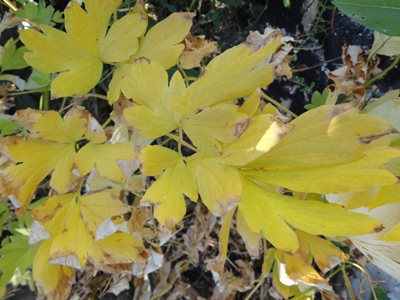In-stock only. Sale items do not carry a warranty.
Why Is My Plant Turning Yellow?
Now that summer has officially arrived our customers are naturally interested in how the hot weather is affecting their plants. We make it a point to remind everyone that summer is still a great time to plant. The key to successful summer planting is providing sufficient water to your new transplants.
But what if one or more of your plants start to turn to yellow this summer? Does that mean all your effort has been in vain? Not necessarily. In this article we’ll look at a couple examples of plants that frequently scare their owners by turning yellow, and we’ll provide you with some tips so that you know what to do about it.
1. Identify a Healthy Plant
First, it’s very important to know what a healthy plant looks like. For example, if you walked out and saw that the foliage on your bleeding heart looked like this, what would you think?

Perhaps your first reaction would be, “Oh no! It’s dying!” Actually, old-fashioned bleeding hearts are supposed to look like that in summer. Once the weather starts to get hot, bleeding hearts protect themselves by shedding their tender, succulent foliage. Don’t worry. They’ll be back as vigorous as ever next spring. If you find the yellow foliage to be unattractive, you can simply remove it.
2. Determine Why Your Plant Is Unhealthy
River birch is another plant that often fools people. It’s normal for quite a few leaves to turn yellow and drop off your river birch in summer. The yellowing leaves are just part of the plant’s response to the hot weather. However, if all of the leaves turn yellow, that’s another problem altogether. Be sure to bring a photo or a sample of the tree into the nursery. From there we can help you decide what the problem is.
In the case of the river birch that turns almost completely yellow, the problem is mostly caused by an iron deficiency as a result of highly alkaline soil. You can see the tell tale signs of iron deficiency in the following photo.

3. Decide on a Remedy
After coming to the nursery and determining the reason for the yellowing of your plant, we will be able to help you decide what action to take. Many times, our customers are relieved to hear that our advice is to leave the plant alone. This would certainly be the case for most river birches that drop some of their leaves in summer.
However, in more serious cases, we can provide you with the knowledge and equipment to fix the problem. Our iron chlorosis treatment can work wonders on river birches planted in alkaline soils.
So next time you see your plant start to turn yellow, don’t panic. Simply follow these three steps. If you’re ever in doubt, be sure to stop by the nursery and ask one of our experts on staff. We would be happy to help.




